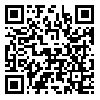Volume 5, Issue 2 (4-2012)
IJMEHM 2012, 5(2): 1-9 |
Back to browse issues page
Download citation:
BibTeX | RIS | EndNote | Medlars | ProCite | Reference Manager | RefWorks
Send citation to:



BibTeX | RIS | EndNote | Medlars | ProCite | Reference Manager | RefWorks
Send citation to:
Jabbari Beirami H, Bakhshiyan F, Bateni G, Mohjal Shojaae M A, Abbasnejad F, Khalili M. The Model of Sheikh Fazloallah Hammadani in health system management. IJMEHM 2012; 5 (2) :1-9
URL: http://ijme.tums.ac.ir/article-1-5039-en.html
URL: http://ijme.tums.ac.ir/article-1-5039-en.html
Hossein Jabbari Beirami * 
 1, Fariba Bakhshiyan2
1, Fariba Bakhshiyan2 
 , Gholamreza Bateni3
, Gholamreza Bateni3 
 , Mohammad Ali Mohjal Shojaae4
, Mohammad Ali Mohjal Shojaae4 
 , Faridoon Abbasnejad4
, Faridoon Abbasnejad4 
 , Majid Khalili
, Majid Khalili 


 1, Fariba Bakhshiyan2
1, Fariba Bakhshiyan2 
 , Gholamreza Bateni3
, Gholamreza Bateni3 
 , Mohammad Ali Mohjal Shojaae4
, Mohammad Ali Mohjal Shojaae4 
 , Faridoon Abbasnejad4
, Faridoon Abbasnejad4 
 , Majid Khalili
, Majid Khalili 

1- Health Care Management Department, Tabriz University of Medical Sciences, Tabriz, Iran
2- Tabriz University of Medical Sciences, Tabriz, Iran
3- Institutional Review Board of Iranian History and Culture Center
4- Tuberculosis and Pulmonary diseases Research Center, Tabriz University of Medical Sciences, Tabriz, Iran
2- Tabriz University of Medical Sciences, Tabriz, Iran
3- Institutional Review Board of Iranian History and Culture Center
4- Tuberculosis and Pulmonary diseases Research Center, Tabriz University of Medical Sciences, Tabriz, Iran
Abstract: (11424 Views)
In the middle age (500–1500), while European countries were struggling with frightening epidemics such as plague, smallpox, tuberculoses, leprosy, and their medical treatments were based on superstitions and fanaticism, scientists such as Avicenna and Rhazes laid the foundation of the golden period in medicine.
In the late periods of golden centuries, during the Mogul invasion of Iran, Rashidaddin Fazlollah Hamadani devoted a great deal of effort to preserve the knowledge by foundation of the knowledge city of Rabé Rashidi and
Daralshafa (Medical and Health Service College) in Tabriz.
Rashidaddin established a successful health management system which was accordance with the current modern health management systems. The objective of this review is to present a clear perspective of a successful Iranian Islamic model of health delivery system 700 years ago.
The review was conducted in the form of descriptive bases of original documents with a systemic approach.
Findings show a successful management experience in health system in terms of stewardship, resource allocation, provision of health services and financing which appears to be in accordance with the World Health Organization (WHO) declaration in 2000.
Promotion of team working, employment of fulltime and part-time physicians, implementation of a fair and functional economic structure, health economic, sustainable financial mechanisms, public insurance, home care provision, and isolation of communicable diseases in hospitals can be considered as examples of a successful Iranian Islamic health management system.
It can be concluded that as Iranian health management system is faced with many different challenges, gleaning lessons from successful national historical experiences can play a key role in the establishment of a competent system based on our Islamic and national values and in accordance with modern scientific achievements.
Type of Study: Review |
Subject:
History of Medicine
Received: 2013/06/15 | Accepted: 2013/10/14 | Published: 2013/10/14
Received: 2013/06/15 | Accepted: 2013/10/14 | Published: 2013/10/14
Send email to the article author
| Rights and permissions | |
 |
This work is licensed under a Creative Commons Attribution-NonCommercial 4.0 International License. |



